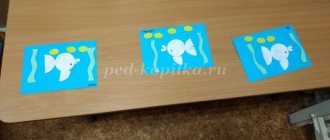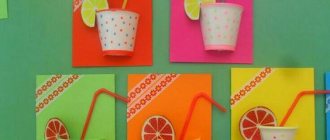Summary of a game lesson for children of the third year of life Topic: “Space”
Summary of a game lesson for children of the third year of life
Theme: "Space"
Goals:
Give children a basic understanding of space.
Activate the dictionary on this topic.
Continue to form stable ideas about shape, size, quantity, color, geometric shapes, and the position of objects in space.
Teach children to perform simple experiments with sand and water.
Improve your drawing, gluing, and sculpting skills.
Develop thinking, fine motor skills, coordination of movements.
Equipment:
Globe.
Multi-colored buttons, a silhouette image of a flying saucer with glued circles, corresponding to the buttons in colors and sizes.
A picture of aliens and their planets in the form of geometric shapes.
Picture-scheme depicting a rocket made of geometric shapes, geometric shapes cut out of cardboard.
A picture depicting astronauts in three sizes, spacesuits cut out of white cardboard in three sizes.
A cone glued together from thick paper. Stickers in the form of circles, a red napkin.
Glued to black cardboard are a rocket, an astronaut on a cord, and a large and small planet.
Glue, sand, a sheet of paper with a round stencil attached to the top.
Container with sand. Pipette. Glass of water.
Multi-colored clothespins, silhouette images of dinosaurs made of thick cardboard.
A background sheet with images of three planets of different sizes, glue, colored silhouette pictures of dinosaurs of three sizes.
A sheet of paper with a round stencil attached to the top, a foam swab, blue paint.
Planar images of whales in three sizes.
A picture depicting the planet Earth and shadows from stones of different shapes, stones. Silhouette image of a rocket.
A sheet of black cardboard, yellow and orange plasticine, paint, stamps with bubble wrap.
Equipment for dynamic pause: bench, correction track, tunnel.
Small brooms and dustpans.
Audio recordings: “Song of young cosmonauts.”
Progress of the lesson:
You and I live on planet Earth. This is what she looks like. (Show the globe).
During the day, when it is light, we see the Sun in the sky. And at night, when it is dark, many stars light up in the sky. People looked at the sky and dreamed of flying there, into space. We learned how to build rockets and flew into space. Now they dream of flying to other planets where aliens live. We can't fly into space on a real rocket. And we can play space adventures. Let's start now.
But aliens from other planets flew to us on a flying saucer. How do we greet them? What shall we say? Hello hi!
Flying Saucer Button Game
Place buttons of the appropriate size and color on the circles.
Didactic game “Return the aliens to their home planets”
What geometric figure does this alien resemble? It looks like a circle. So he came from a round planet. What geometric figure does this alien resemble? To the oval. So he's from an oval planet. Return all aliens to their home planets.
It's time for us to fly into space. We need to build a rocket.
Didactic exercise “Fold the rocket”
Take a rectangle and find its place on the image of the rocket. Now lay out the square and triangle. We have one of each of these figures. How many circles? Two circles. Lay them out in the form of porthole windows. Now count the ovals. How many ovals? Three. Find a place for them.
Didactic game “Choose a spacesuit by size”
The astronauts are in front of you. Show the highest, the lowest. Now choose suits that fit them.
Paper construction “Rocket”
Children glue porthole circles onto a cone of thick paper, crumple up a red napkin and insert it into the hollow part of the cone - “fire”
Before the flight, astronauts must practice.
Dynamic pause “Cosmonaut training”
Children crawl along a bench, crawl into a tunnel, and walk along a corrective path. To the music of “Song of Young Cosmonauts”.
And now that we have everything ready, let's take off!
Didactic exercise “In outer space”
Position the astronaut in the rocket. It's time to exit the rocket into outer space. Here is an astronaut landing on a big planet. Now back on the rocket. He came out again and flew around the rocket. Then he landed on a small planet.
sand planet
Handmade “Planet of Sand”
A stencil is applied to a sheet of paper and secured with paper clips.
Apply glue to the circle inside the stencil and sprinkle it with sand.
Sand experiment “Dry or wet”
There is sand in front of you. Touch it. Is the sand wet or dry? Dry. How to make sand wet? Pour the water. Use pipettes to pour water into the sand. What did the sand become like from the water? Wet.
Dinosaur Planet
Game with clothespins "Dinosaurs"
Attach spikes to the backs of dinosaurs so they can protect themselves from enemies.
Application "Dinosaurs"
Stick the big dinosaur on the big planet and the small dinosaur on the small planet.
Planet of water
Drawing with foam swabs “Planet of Water”
A stencil is applied to a sheet of paper and secured with paper clips.
A foam swab with blue paint leaves imprints that fill the entire space inside the stencil.
Who do you think can live on planet water? Fish, whales.
Dynamic pause “Whale Trip”
A flat image of a whale is laid out on the floor, and children are invited to sit on it to swim on the planet of water.
The whale is not very big, it’s cramped for us. And then another whale swam up to us. Is it bigger than ours or smaller? This whale is bigger than ours. Let's get on this whale. Which one is bigger. Now we are not cramped. We have plenty of space.
Planet of the Rocks
Didactic game “Find the shadow of the stone”
Place stones of suitable shape on the black shadows.
Didactic exercise “Guide a rocket through a meteor shower”
Pick up a rocket and place it on planet Earth. Now the rocket is on its way. Help the rocket fly through the meteor shower and avoid crashing into the rocks.
Exercise “Collect stones”
There are many rocks scattered on this planet. You need to collect them, but you cannot touch the stones with your hands. We will collect stones using brooms and dustpans. Like this.
Modeling “Star and Comet”
On a piece of black paper, children make an image of a star and a comet.
Star: roll out a ball in a circular manner, apply it to the cardboard and press down, pull the plasticine to the sides with your finger - make “rays”.
Comet: roll out a ball in a circular motion, place it on the cardboard and press down, pull out the “tail” of the comet with your finger.
Drawing with stamps with bubble wrap "Planets"
Dip the stamp in paint and apply it to a dark sheet of paper - you will get a planet.
It's time to return home to our planet Earth.








